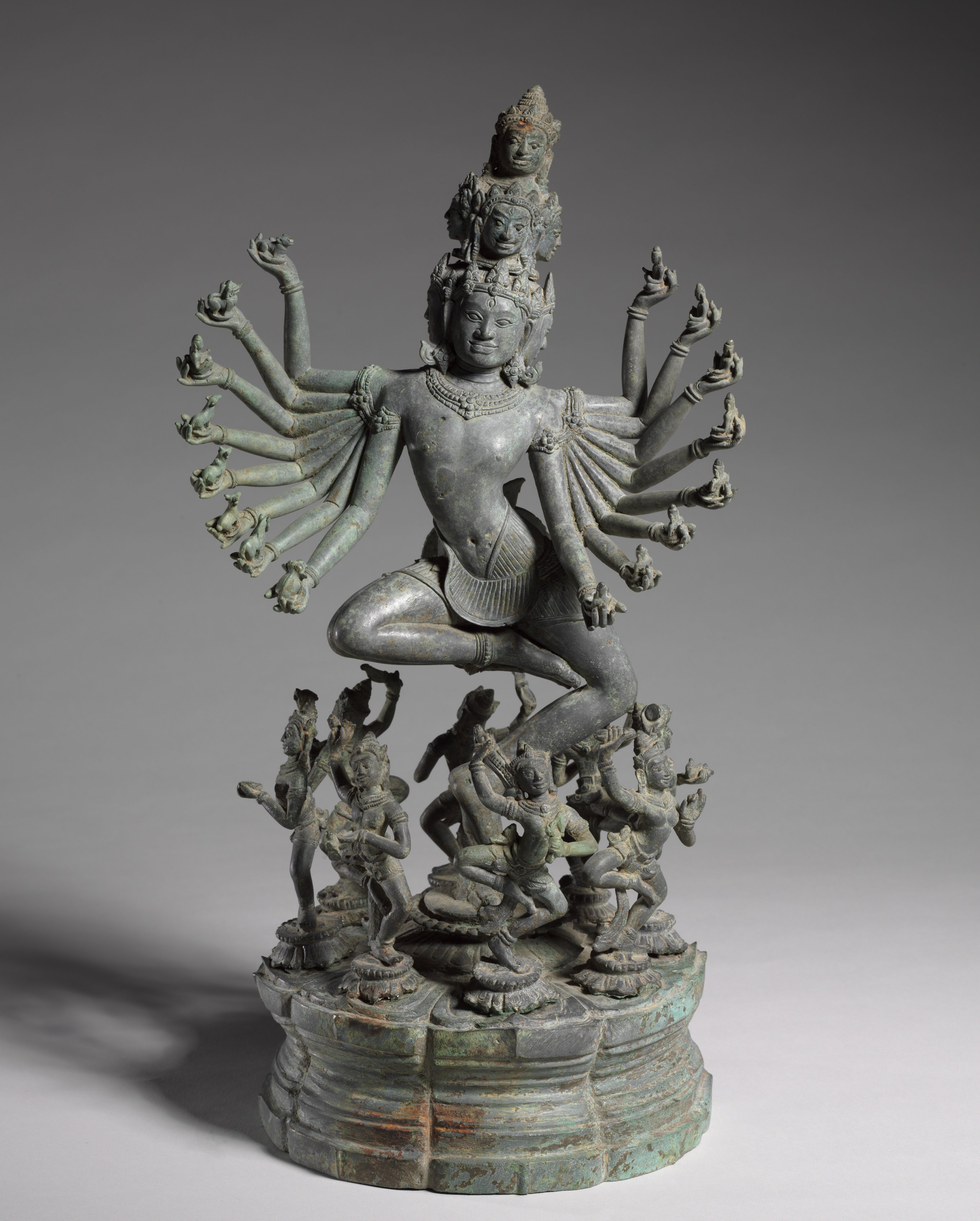The Cleveland Museum of Art
Collection Online as of April 19, 2024

Hevajra
c. 1200
Overall: 46 x 23.9 cm (18 1/8 x 9 7/16 in.)
Location: not on view
Did You Know?
Hevajra, the Tantric Buddhist deity who personifies Enlightenment, dances vigorously to symbolize the human soul's liberation from the snare of existence.Description
Hevajra was an important figure signaling the practice of Buddhist rituals. King Jayavarman VII placed particular emphasis on Hevajra during consecration rituals and set up a colossal stone sculpture of dancing Hevajra at the east gate of his fortified city in the Khmer capital at Angkor. In the Cambodia of Jayavarman VII, tantric Buddhism became public and widespread, practiced together with other more mainstream forms of Buddhism, Hinduism, and ancestor worship.The iconography of Hevajra is described in detail in a text that bears his name, the Hevajra-tantra, first composed in India probably in the 800s. Hevajra has eight heads, sixteen arms, and four legs. His left hands hold images of Indic gods; wealth, death, sun, moon, fire, wind, water, and earth. In his right hands are animals: bull, lion, human, cat, camel, sheep, horse, and elephant. They all sit in skull cups, objects also used in tantric rituals. He dances on a corpse that embodies ignorance and is surrounded by eight yoginis who dance triumphantly in a ring around him. Yoginis functioned as intercessors between human practitioners and enlightened beings.
Many bronze images of Hevajra were made during the reign of Jayavarman VII, but few survive in as pristine condition as this example. According to scientific analysis and curatorial reports, this sculpture survived in a clay vessel submerged in water, which accounts for its high tin content and unusual gray patina. Samples from the clay core reveal the presence of the mineral feldspar, a characteristic of clay from the Isaan plateau, on the other side of the mountain range not far from Banteay Chhmar, in present-day Thailand.
- ?–December 1987(Chai Ma Antiques, Bangkok, Thailand, sold to Maxeen Stone Flower)December 1987–2011Dr. John A. [1921–2011] and Maxeen Stone Flower [1928–2010], Shaker Heights, OH, bequest to the Cleveland Museum of Art2011–The Cleveland Museum of Art, Cleveland, OH
- Franklin, David and C. Griffith Mann. Treasures from the Cleveland Museum of Art. Cleveland, OH: The Cleveland Museum of Art, 2012. Reproduced: pp. 98-99“Art of Asia Acquired by North American Museums, 2010-2011.” Archives of Asian Art, vol. 62, 2012, pp. 105–153. Reproduced: 118, fig. 15 www.jstor.org"Recent acquisitions (2005-11) at the Cleveland Museum of Art." The Burlington Magazine 1312:154 (July 2012): pp. 525-532. Reproduced: fig. VII, p. 527Cleveland Museum of Art. The CMA Companion: A Guide to the Cleveland Museum of Art. Cleveland: Cleveland Museum of Art, 2014. Mentioned and reproduced: P. 220-221Bassoul, Aziz. Splendour of Khmer Iconography: Ancient Cambodian Art of the 5th to the 13th Centuries in Major World Museums and Private Collections. Beirut: Cedar of Lebanon Editions, 2018. Mentioned and reproduced: pp. 322-323, no. 145McGill, Forrest. "Dancing in Circles." In Beyond Bollywood: 2000 Years of Dance in the Arts of South Asia, Southeast Asia, and the Himalayan Region. Forrest McGill, ed., 33-47. San Francisco, CA: Asian Art Museum, 2022. Reproduced: p. 35, fig. 4; Mentioned and Reproduced: pp. 146–147, no. 33
- Beyond Bollywood: 2000 Years of Dance in Art. The Cincinnati Art Museum, Cincinnati, OH (organizer) (November 11, 2022-February 5, 2023) https://www.cincinnatiartmuseum.org/art/exhibitions/upcoming-exhibitions/beyond-bollywood-2000-years-of-dance-in-art/; Asian Art Museum of San Francisco, San Francisco, CA (March 31-July 10, 2023) https://exhibitions.asianart.org/exhibitions/beyond-bollywood-2000-years-of-dance-in-art/.Beyond Angkor: Cambodian Sculpture from Banteay Chhmar. The Cleveland Museum of Art, Cleveland, OH (organizer) (October 14, 2017-March 25, 2018).
- {{cite web|title=Hevajra|url=false|author=|year=c. 1200|access-date=19 April 2024|publisher=Cleveland Museum of Art}}
Source URL:
https://www.clevelandart.org/art/2011.143